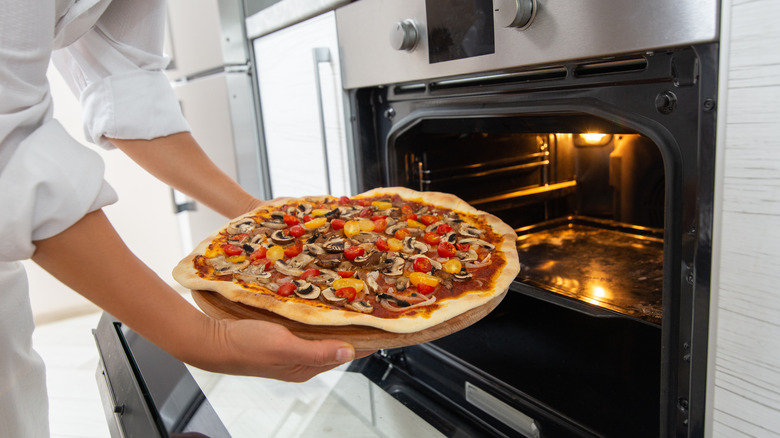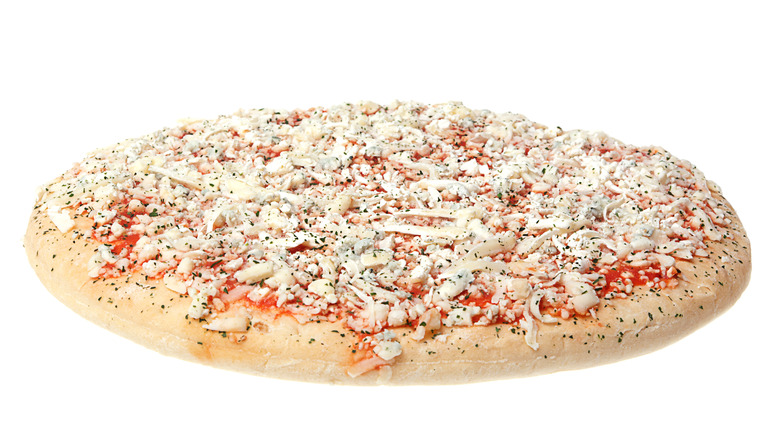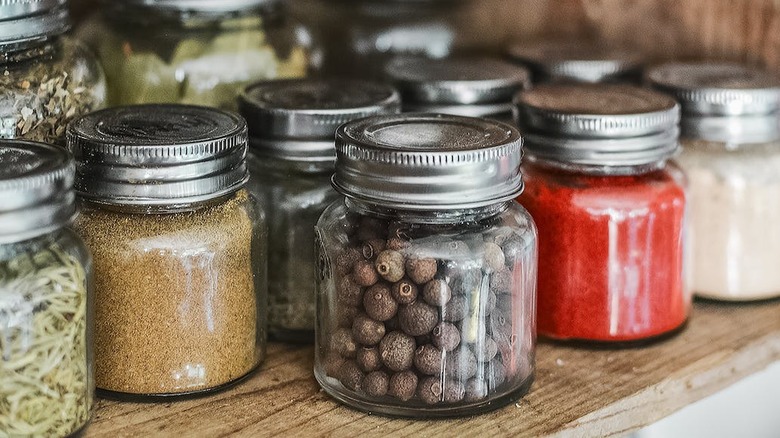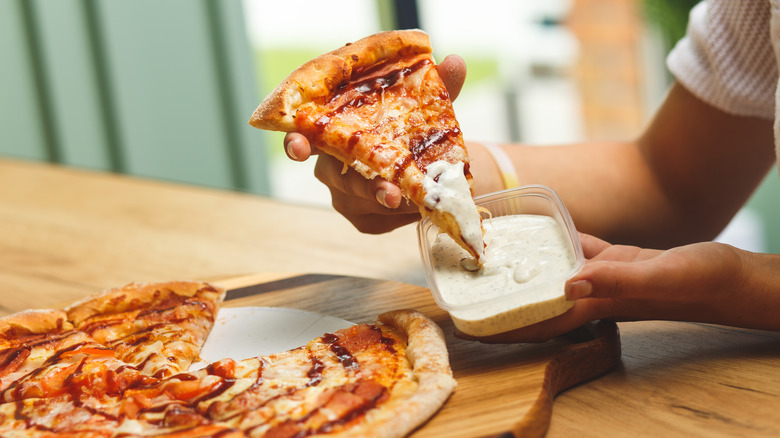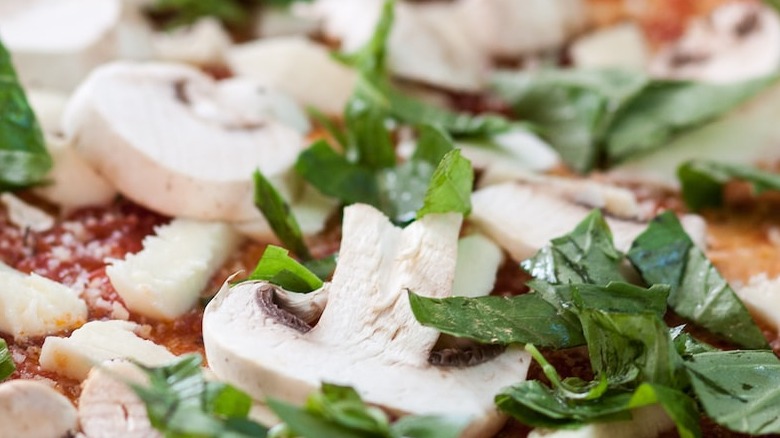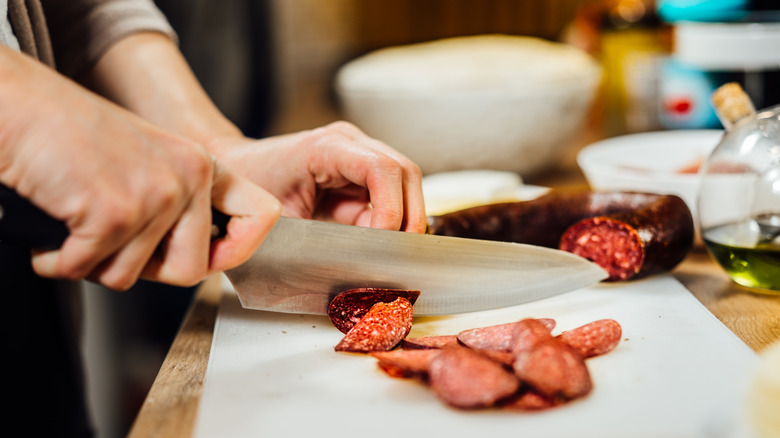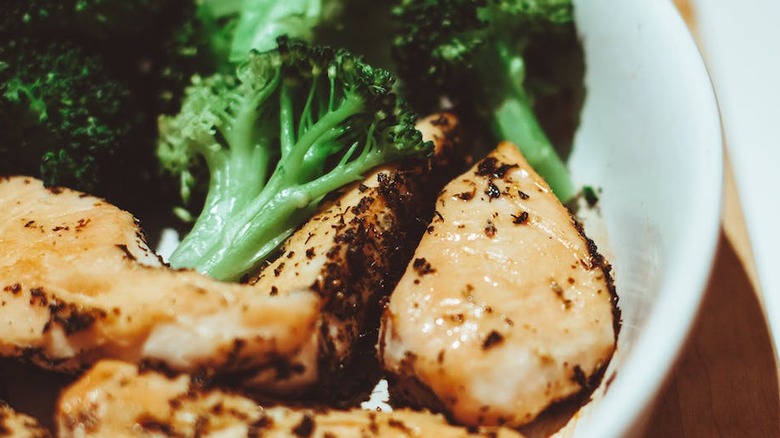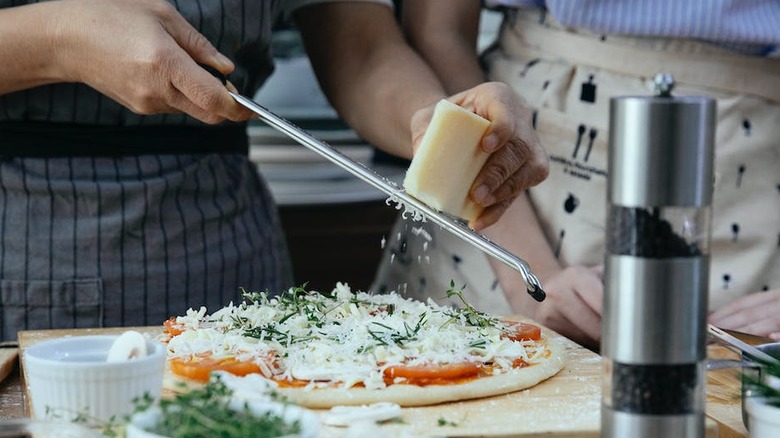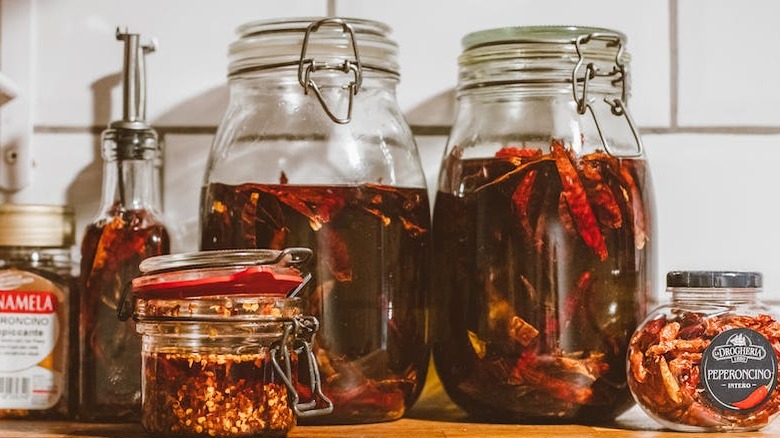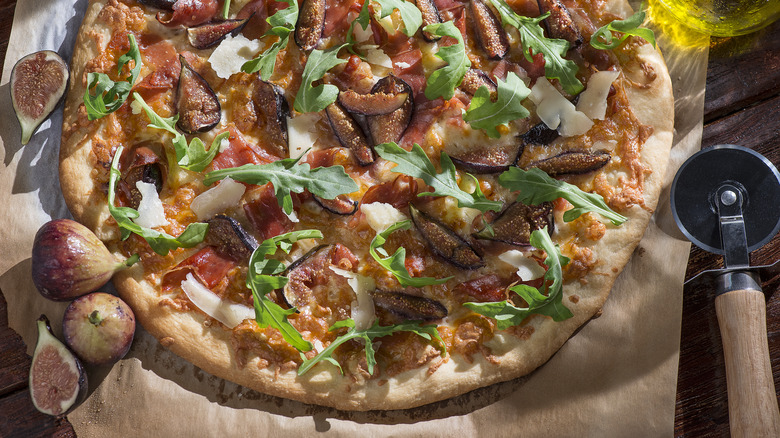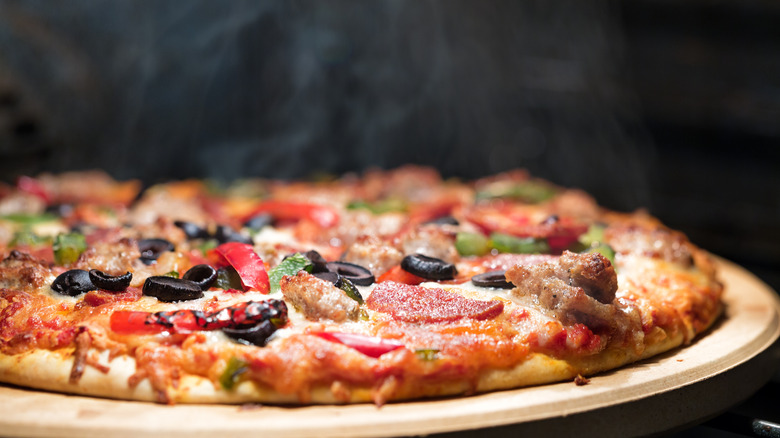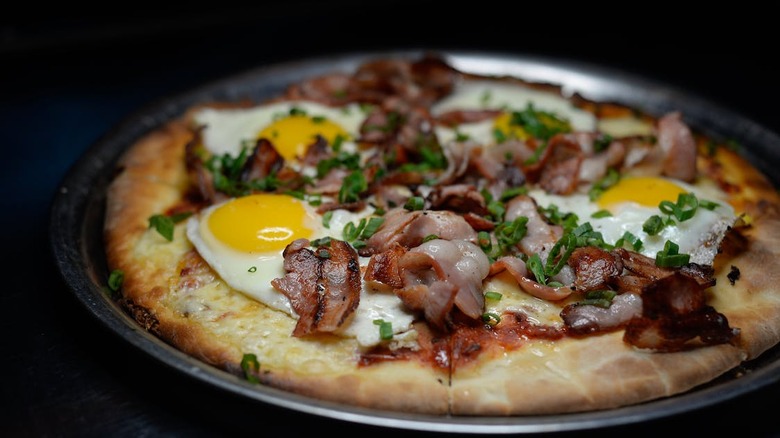12 Ways To Upgrade Your Frozen Pizza
Let's face it –– pizza delivery is expensive. While it's an attractive option for a quick dinner after a long day, you may be looking for cheaper alternatives that let you get a slice of the action. Enter the frozen pizza. Since its invention in the 1950s, this grocery store staple has always been a cornerstone of take-and-bake meals for folks on the go, per CNBC. It's not slowing down anytime soon, either. A forecast performed by Allied Market Research reports that the frozen pizza market will "reach $39,373.20 million by 2031."
Frozen pizza isn't only an easy way to eat at home and save a couple of bucks, but it can also be easily upgraded from basic to brilliant. From having essential kitchen tools on hand to selecting a pizza and toppings, we'll walk you through 12 ways you can upgrade your frozen pizza to rival your local pizzeria in this guide. Hope you're hungry!
1. Choose the right base pizza
To kick things off, let's go back to basics. Your end result will only be as good as the frozen pizza and toppings you use, so it's essential that you purchase quality ingredients. It doesn't need to be an intimidating process, as it just requires some planning ahead. First, check your pantry to see what ingredients you have on hand that you can use, like chopped nuts and sauces.
You'll then need to choose a pizza base. Cheese pizza will most likely be your best bet, providing a blank canvas for your toppings. Cheese is also an attractive option because the mild flavor shouldn't conflict with the toppings you add. That doesn't mean you can't vie for other options like pepperoni, just keep in mind how the ingredients you add will work with the pizza base you're building upon.
For toppings, take a gander at your local farmer's market for fresh vegetables, fruit, meat, honey, and other ingredients. Not only is it a way to support your community, but, according to The University of Maine, local produce contains a higher nutritional value –– talk about a win-win. If you don't live near a farmer's market but want to cash in on some deals, check your local grocery store ad for sales on seasonal produce.
2. Season your heart out
A good crust can make or break a pizza and seasonings can play a huge role. Take this as an opportunity to experiment. Spice cabinet staples, such as oregano, rosemary, cumin, and paprika, are prime contenders for pizza crust additions. Work them into the dough prior to baking, sprinkle them on as a finishing touch, or pair them with oil and drizzle on top.
While you can certainly keep things classic, you could also get adventurous and add Cajun seasoning to your pizza for a kick of spice. Popcorn seasoning adds a cheesy and nutty flavor that works well with pepperoni, while Greek seasoning added to a veggie pizza will elevate the savory notes.
When selecting seasonings, keep the other ingredients in mind to ensure they all work in harmony. When in doubt, garlic is a solid way to get delicious flavor incorporated into your dish.
3. Get saucy with more sauce toppings
Pizza lovers are familiar with the various sauce bases that come with a standard pizza, such as marinara red sauce, cheese-based white sauce, pesto, oil, or no sauce at all. In some cases, like with Chicago-style pizzas as created by Chicago-based Pequod's Pizza, the sauce is piled on top. There are also dipping sauces, like sriracha, hot sauce, ranch, and bleu cheese, that can give a flavor boost with every bite of pizza. Adding a drizzle of hot honey or a swirl of buffalo sauce can offer a unique, easy way to elevate your frozen pizza. Chances are you may already have them in your fridge as well.
Experiment with fruit preserves, balsamic, barbecue sauce, and even gochujang. The trick is to avoid being heavy-handed when adding this pièce de rèsistance (unless it's your thing to add copious amounts, then go right ahead)!
4. Add fresh veggies and herbs
Salad isn't the only way you can get your daily serving of vegetables. Whether you are envisioning a prosciutto, arugula, and balsamic pizza creation or even a taco pizza loaded with bell peppers and onions, there are many benefits to using vegetables as pizza toppings, including adding extra texture, flavor, and color.
Using herbs, such as basil and parsley, works in complementary, bright flavors to accompany the other components of your pizza and also add a nutritional kick. They act as anti-inflammatory agents thanks to naturally occurring compounds called polyphenols and fuel the body with important vitamins and antioxidants, per Michigan State University. Additionally, some herbs can be key in preventing serious diseases in the long run, like cancer and heart disease (via Harvard T.H. Chan School of Public Health).
Take a stroll through your garden, the farmer's market, or your grocery store's produce aisle to stock up on veggies, herbs, and produce. Not only will you enjoy the fresh and seasonal flavors, but you'll also be adding additional nutrients.
5. Pile on the meat
If you consider yourself the carnivore type and always go for the savory, meat-lovers pizzas, you can recreate that experience with frozen pizza as well. There really are no rules when it comes to adding more protein, other than following your cravings. Take inspiration from your favorite deli sandwiches and meat-based dishes and replicate them as toppings on your pizza. Chop up chicken breast and mix it with buffalo sauce to come up with your own buffalo chicken pizza creation, or brown some ground beef in a skillet for chili pizza.
If you are taking a more old-school approach with your pizza, adding in cured meats like savory and salty crumbled bacon, prosciutto, chorizo, or salami can pack an umami punch. You can also opt for juicy pork belly, sliced steak, or in a pinch, dice up some cold cuts before generously applying them to your pizza.
6. Layer in your leftovers
Trying to use up some leftovers? Consider them as pizza toppings. It's not only an opportunity for a fridge cleanout but also an upgraded dinner. Using leftovers on your pizza requires a bit of creativity but can help you save a few bucks and prevent needless food waste.
For protein toppings, chop up meatballs from last night's spaghetti as a savory topping, or use baked ham if you're going the Hawaiian pizza route. Need to use up some seafood fast? Layer on your cooked shrimp, scallops, and crab for an impromptu seafood pizza. Cooked veggies can quickly be spun into stir-fry pizza, or keep them raw for some extra crunch in a classic vegetable pizza. If your kids didn't touch their dinosaur chicken nuggets from dinner, they too qualify as a pizza topping. Chop them up and toss with barbecue sauce, or keep them as-is if you're feeling a more prehistoric-themed pizza.
7. Grate on more cheese
Pizza isn't complete without cheese. Possibly the most gratifying part of this dish, there's no arguing the excitement you feel as you watch the warm, stretchy strings of cheese multiply as you pull a slice from the pie. For frozen pizza, there's no need to hesitate when adding extra cheese as a topping. Just do it. And if you needed an excuse to visit the cheese section at the deli, consider this your opportunity.
An extra helping of cheese, especially mixing different varieties together, can result in an excellent end result. Mozzarella is the most common component of any pizza and has great melting properties. Soft cheeses, like ricotta, burrata, brie, mascarpone, gorgonzola, and even goat cheese, add a smooth, creamy texture with fresh flavor. Hard cheeses, like parmesan, romano, and gruyere, yield heartier, nuttier flavors. You can purchase these cheeses pre-grated or in a block, but as Ina Garten remarked in an interview with Time magazine, you shouldn't buy grated parmesan as homemade tastes better (and is easy to make!). Time to roll up your sleeves and get grating for a cheesy, delicious payoff.
8. Try flavored oils
If you've ever had a hot slice of pizza with Calabrian chili oil at your local pizzeria, you understand how these chilis can turn up the dial when it comes to heat. The thin, red peppers come from the southern Italian region of Calabria and are woven into many Italian recipes, per La Cucina Italiana. While Calabrian chilis are more of a specialty item and thus, a bit harder to get your hands on at the grocery store, you can replicate them at home with some red chili flakes and extra virgin olive oil. If you're in the mood for a more savory oil or one of lesser rank on the Scoville Heat Scale, you can opt for jalapenos. Extra virgin olive oil is a must for creating a peppery drizzle or sauce.
Remember, use oil for dipping or as a drizzle and not an oil slick. Too much, and you may be risking turning your pizza from chewy and crispy into soggy.
9. Layer on fresh fruit
When you think of fruit on pizza, your mind probably goes to the infamous pineapple first. While 54% of Americans strongly disagree with pineapple as a pizza topping (according to a 2017 survey by Slice), the reality is that it can be a game-changer. In Italy, the birthplace of pizza, fruits such as figs and grapes are used seasonally as pizza toppings (via La Cucina Italiano).
Apples or stone fruits, such as cherries, peaches, or apricots work well as toppings. Put your charcuterie hat on and pair each with a cheese that best compliments it. Add in some crushed nuts and a sauce topping, such as balsamic or infused oil, to pull it all together.
Whether you opt for fresh fruit or fruit preserves, it can promote the savory-sweet flavor combination you've been looking for. And if you're still not sure if you can do fruit on pizza, just remember that tomatoes are indeed fruits.
10. Experiment with your cooking method
Since the vast majority of folks don't have a brick or commercial-grade pizza oven at home, there are ways to still get that pizzeria experience (and avoid the betrayal of soggy pizza slices). "Flash baking" is a surefire way to get an evenly cooked, crisp crust on your pizza in a short amount of time (via Cooking Light). Be sure to thaw your pizza ahead of time, and crank up your oven as high as it will go. As soon as the pizza is at room temperature, throw it in the oven for up to eight minutes.
While a pizza stone requires a bit of prep work, it is an easy way to enhance your pizza as it helps you get a light and crispy crust, especially with the flash-baking method. Cook's Illustrated notes that it's best to preheat the clay disc for 45 minutes to an hour beforehand to help the pizza crust cook evenly. When it's time to cook your pizza, place it atop the stone and keep an eye on it until it reaches your ideal level of crispiness.
A pizza stone isn't the only method for cooking your pizza gourmet-style. While it's not wood-fired, your grill can be a great way to cook your pizza to perfection. Weber advises heating your grill to 425 to 450 degrees Fahrenheit. Once it's hot, transfer your pizza directly onto the grill for 16 to 20 minutes. You can also use your pizza stone on the grill to indirectly cook your pizza over the flames.
11. Let it sit
Just as you would when baking cookies, give your pizza a minute to cool off once the cooking has gone off and you've taken it out of the oven. If you cut into the pizza too quickly while the cheese is still steaming and oozy, the ingredients can slide off, leaving you with a bare crust and a pile of toppings on your plate. On the other hand, some toppings are better added after the crust has cooked to avoid singing and wilting, such as spinach.
Use a pizza peel or rimless baking sheet to carefully lift your pizza off the stone. For seamless transfer, AK Crust notes that using cornmeal, semolina flour, regular flour, or a blend of all three are common ways to prevent your pizza from gluing itself to the peel. If you want to avoid the extra crunch cornmeal can leave on the bottom of your crust, go with flour for your pizza peel.
12. Use breakfast ingredients
No need to wait till Sunday brunch to get a breakfast pizza, because you can replicate pizzas created by premier chefs right at home. If you plan as using eggs, chefs recommend following a similar process to that of cooking your frozen pizza gourmet-style with the help of a pizza stone and high heat (via The Columbian). Crack the egg atop the pizza halfway through cooking (about 4 minutes if you have the pizza stone), or opt to poach an egg in hot water on the stovetop before serving.
You're not limited to just eggs on a breakfast pizza, either. Crumble up some bacon, sausage, or meat of choice and sprinkle on feta or a smidge of sharp cheddar. You can stop there if you're a true carnivore, or add in some herbs and vegetables, like green onions and parsley. Hash browns or breakfast potatoes, another traditional breakfast side dish, can be reinvented for frozen pizza. If you don't have any on hand, thinly slice up Yukon gold potatoes and layer them on top of your pizza before popping it back into the oven. Finish off with some rosemary, salt, pepper, and enjoy!
